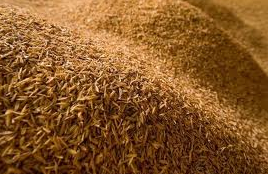Rice Husk

Rice husk is the byproduct of rice processing, the weight of which can amount to 20% of the rice. Rice husk is a kind of renewable energy widely used in sugaring or as fuels for industry or home heating. While as the content of combustible is more than 70%, the most important use of rice husk is to use as fuel.
Traditionally, rice husk can be burned directly in the boiler, or be processed into bulk. However, the rice husk cannot be burned efficiently by using the above ways since the density of rice husk is low. And what’s more, there is much air pollution when burning the rice husk directly. While how to use rice husk efficiently? To transfer the rice husk into biomass pellets can be an available solution.
There are some advantages to make the rice husks into wood pellets. First, rice husk pellets can burn longer than rice husk. After being pelletized, the combustion rate of rice husk can run up to above 95%. Second, rice husk pellets are easier to be stored. When rice husks are made into pellets, the density is greatly improved which making them more convenient to be stored in large quantity. Third, rice husk pellets burn cleaner. When burning directly, the ash content of rice husk is about 15-16%, while the ash content of rice husk pellet is only about 6-7%. Here in the following we will make a comparison about the parameters of rice husk and rice husk pellet.
Sunflower Husk
Sunflower husk is the byproduct of sunflower seed, which was threw away or burned in the past. However, since it is of low ash content and high calorific value, sunflower husk actually is a kind of biomass fuel which can be used as fuel resources.
But when sunflower husk is burning directly, it cannot be burned efficiently and will cause air pollution to the environment. So how to use sunflower husk more efficiently? There come wood pellet mills. Wood pellet mill can transfer the sunflower husk into high quality sunflower husk pellet.

As the raw material of wood pellet mill, sunflower husk has superiorities over other raw materials for that sunflower husk don’t need to be crushed before pelletizing. The average length of sunflower husk is about 8.40 mm which is available for pelletizing.
When the sunflower husk is processed into pellet, the energy has largely improved. Sunflower husk pellets can burn longer and more efficient than sunflower husk What’s more, sunflower husk pellets burn much cleaner. Here is a table to compare the sunflower husk and sunflower husk pellet:
When sunflower husk becomes pellets, the density is higher, the ash content and moisture content are lower. All these factors indicate that the sunflower husk pellets are a kind of renewable, clean and eco-friendly fuel energy.
We specialize in renewable biomass energy solutions. Our company is a world leader in biomass gasification and pellet manufacturing systems.
We offer turnkey projects for complete biomass and wood pellet plants. Our machines are the highest quality and lowest price.
 Rice husk is the byproduct of rice processing, the weight of which can amount to 20% of the rice. Rice husk is a kind of renewable energy widely used in sugaring or as fuels for industry or home heating. While as the content of combustible is more than 70%, the most important use of rice husk is to use as fuel.
Rice husk is the byproduct of rice processing, the weight of which can amount to 20% of the rice. Rice husk is a kind of renewable energy widely used in sugaring or as fuels for industry or home heating. While as the content of combustible is more than 70%, the most important use of rice husk is to use as fuel.